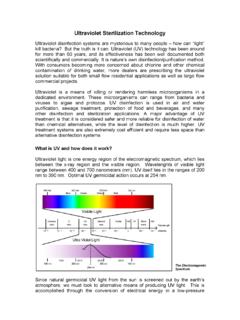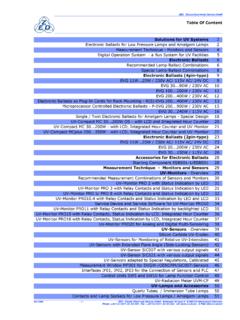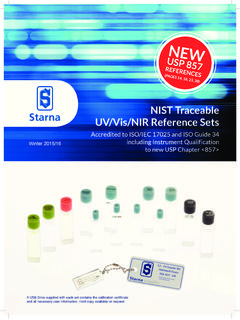Transcription of All you wanted to know about UV radiation and …
1 All you wanted to know about UV radiation and plants by Alenka Gabers ik, Alan Jones and Marcel Jansen Sunlight, in its many guises, is force that has shaped and driven the miraculous living fabric of this planet for billions years. It embodies the best engineering, the widest safety margins, and the greatest design we experience now. It provides amply for our needs, yet limits our It is safe, eternal, universal and free. Theodore B. Taylor, Sceptic (1977) This quotation summarises the essence of the importance of sunlight for our planet. Part of sunlight is radiation in the UV range which has been one of engineering tools that significantly contributed to the diversity of the present Earth biocenosis, the community of all interacting organisms.
2 In spite of this, the attitude of the public towards UV radiation is usually one of negativity. The majority of people associate UV radiation with sun burns and skin cancer, while little awareness exists of the positive role of UV radiation in our lives. On this web page you can find descriptions of the effects of UV radiation that enhance our lives. Sunlight, in its many guises, is force that has shaped and driven the miraculous living fabric of this planet for billions years. It embodies the best engineering, the widest safety margins, and the greatest design we experience now. It provides amply for our needs, yet limits our It is safe, eternal, universal and free. Theodore B. Taylor, Sceptic (1977) The nature of light on the Earth Sunlight is electromagnetic radiation coming from the sun.
3 It consists of a spectrum of visible and non-visible energy with different wavelengths. The most important parts of sunlight for life on Earth are ultraviolet radiation , visible light and infrared radiation . Packages of light (photons) coming from the sun travel directly through space, as long as nothing obstructs them. The amount of solar radiation just outside the Earth s atmosphere is therefore more or less constant ( about kW/m ). Different particles in the atmosphere affect the quantity and quality of incoming radiation . Photons are absorbed, scattered, and reflected by the ozone layer in the stratosphere as well as by gasses, aerosols, clouds and other particles ( dust or different pollutants) in the troposphere.
4 As a result only about half of the total solar radiation reaches the Earth s surface. Different wavelengths of light are affected differently by dust particles or water droplets. Thus, different wavelengths of light that hit water droplets are reflected into different directions, resulting in a rainbow. What is UV radiation ? Ultraviolet radiation (UVR) is a type of solar radiation with wavelengths between 100 and 400 nm. It ends where the colours of rainbow start. The atmosphere absorbs all UV-C (< 280 nm), a significant part of UV-B (280 315 nm) but transmits most of the UV-A radiation (315 400 nm). UVR represents only about 7-9 % of total solar radiation reaching the biosphere, but unlike other types of solar radiation , UVR is highly energetic radiation .
5 This means that UVR can cause reactions between molecules that are hit by such radiation . UV radiation ends where the colours of the rainbow begin Visible light consists of different colours which can be seen as a rainbow when shone through a prism, or when sunlight shines through raindrops. Reflected light from water vapour (clouds) appears white because it contains all colours. Blue light is of shorter wavelengths. It is scattered by gas molecules and is why the sky appears blue. Sunlight, in its many guises, is force that has shaped and driven the miraculous living fabric of this planet for billions years. It embodies the best engineering, the widest safety margins, and the greatest design we experience now. It provides amply for our needs, yet limits our It is safe, eternal, universal and free.
6 Theodore B. Taylor, Sceptic (1977) UV radiation and plant photosynthesis enable the existence of protective ozone layer The Earth s biosphere is protected from short-wave UVR by an ozone layer in the stratosphere. The formation of this ozone layer has been possible due to photosynthesis, in which plants take up carbon dioxide and release oxygen (O2). When UV photons (especially UV-C) hit O2 molecules these fall apart to atoms of oxygen, which in turn, react with remaining O2 to form ozone (O3). The ozone layer extends from 10 km to 50 km above the Earth s surface, however, t he total amount of ozone is small since the average concentration is only about 8 parts per million (ppm). If condensed to a liquid and spread evenly over the Earth, the ozone layer would be only about 4 micrometers ( m) thick.
7 The amount of ozone is expressed as Dobson units (DU). Normal amount is around 300 DU, which corresponds to 3 mm of pure ozone at a pressure of 1 atmosphere and at 0 C. Worryingly, the ozone layer is very delicate and some chemicals cause its destruction. Reductions in the ozone column, primarily due to the anthropogenic ( by humans) discharge of chlorofluorocarbons used in fridges and spray cans have led to substantial increase in UV-B radiation on the Earth s surface. Climate change might additionally affect UVR through changes in cloud formation and albedo. O2 + UV-C photon (< 240 nm) O + O O2 + O + M O3 + M Concern about ozone layer depletion by chlorofluorocarbons led to a very successful international treaty.
8 All major countries in the world jointly agreed to restrict the use of chlorofluorocarbons in order to save the ozone layer. This is the so-called Montreal treaty which was agreed in 1987, and has been hailed as an example of exceptional international co-operation, and an inspiration for the international community in its battle against climate change and loss of biodiversity. UV radiation and plant photosynthesis enable the existence of protective ozone layer The atmosphere is rather thin. The thickness of troposphere and stratosphere which are crucial for the life on Earth is shown in light blue colours. If we compare the Earth with an apple, the thickness of the troposphere corresponds to the apple s skin. TROPOSPHERE STRATOSPHERE WITH OZON MESOSPHERE TERMOSPHERE Thickness of Earth s atmosphere Sunlight, in its many guises, is force that has shaped and driven the miraculous living fabric of this planet for billions years.
9 It embodies the best engineering, the widest safety margins, and the greatest design we experience now. It provides amply for our needs, yet limits our It is safe, eternal, universal and free. Theodore B. Taylor, Sceptic (1977) plants are well equipped to use solar radiation efficiently plants , as primary producers, are fully dependent on solar radiation . Light is their source of energy, driving photosynthesis and directing plant development from germination to flowering. However, light is not just beneficial, but it can also exert warming and destructive effects. Therefore proper equipment to exploit solar radiation efficiently without suffering the damage is crucial for plants . This holds especially true for radiation in the UV range.
10 DNA damage and repair The targets of UVR in any living cell are DNA, lipids and proteins (which form enzymes and hormones). DNA is the genetic material in all living organisms, that is passed on from generation to generation. DNA damage will occur whenever the organism is exposed to UVR. Yet, DNA damage is not simply bad news. UVR has been an important evolutionary force, generating mutations, leading to new traits, and driving the development of species diversity. Mutations are, however, mostly negative, inhibiting vital cellular processes (DNA transcription and replication) and resulting in disturbed cellular function, sometimes even cell death. Fascinatingly, plants exploit blue and UV-A wavelengths to drive DNA repair processes.








